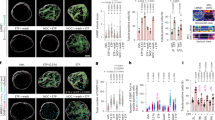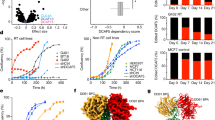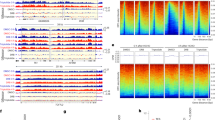Abstract
DNA repair is critical for the maintenance of genome stability. Upon genotoxic stress, dysregulated DNA repair may induce apoptosis. Translin-associated factor X (TRAX), which was initially identified as a binding partner of Translin, has been implicated in genome stability. However, the exact role of TRAX in DNA repair remains largely unknown. Here, we showed that TRAX participates in the ATM/H2AX-mediated DNA repair machinery by interacting with ATM and stabilizing the MRN complex at double-strand breaks. The exogenous expression of wild-type (WT) TRAX, but not a TRAX variant lacking the nuclear localization signal (NLS), rescued the vulnerability of TRAX-null mouse embryo fibroblasts (MEFs). This finding confirms the importance of the nuclear localization of TRAX in the repair of DNA damage. Compared with WT MEFs, TRAX-null MEFs exhibited impaired DNA repair (for example, reduced phosphorylation of ATM and H2AX) after treatment with ultra violet-C or γ-ray irradiation and a higher incidence of p53-mediated apoptosis. Our findings demonstrate that TRAX is required for MRN complex-ATM-H2AX signaling, which optimizes DNA repair by interacting with the activated ATM and protects cells from genotoxic stress-induced apoptosis.
This is a preview of subscription content, access via your institution
Access options
Subscribe to this journal
Receive 50 print issues and online access
$259.00 per year
only $5.18 per issue
Buy this article
- Purchase on Springer Link
- Instant access to full article PDF
Prices may be subject to local taxes which are calculated during checkout









Similar content being viewed by others
References
Roos WP, Kaina B . DNA damage-induced cell death by apoptosis. Trends Mol Med 2006; 12: 440–450.
Kaina B . DNA damage-triggered apoptosis: critical role of DNA repair, double-strand breaks, cell proliferation and signaling. Biochem Pharmacol 2003; 66: 1547–1554.
Hakem R . DNA-damage repair; the good, the bad, and the ugly. EMBO J 2008; 27: 589–605.
Shiloh Y . ATM and ATR: networking cellular responses to DNA damage. Curr Opin Genet Dev 2001; 11: 71–77.
Yang J, Xu ZP, Huang Y, Hamrick HE, Duerksen-Hughes PJ, Yu YN . ATM and ATR: sensing DNA damage. World J Gastroenterol 2004; 10: 155–160.
Symonds H, Krall L, Remington L, Saenz-Robles M, Lowe S, Jacks T et al. p53-dependent apoptosis suppresses tumor growth and progression in vivo. Cell 1994; 78: 703–711.
Lavin MF, Kozlov S . ATM activation and DNA damage response. Cell Cycle 2007; 6: 931–942.
Rotman G, Shiloh Y . ATM: a mediator of multiple responses to genotoxic stress. Oncogene 1999; 18: 6135–6144.
Lee JH, Paull TT . ATM activation by DNA double-strand breaks through the Mre11-Rad50-Nbs1 complex. Science 2005; 308: 551–554.
Zgheib O, Huyen Y, DiTullio RA Jr., Snyder A, Venere M, Stavridi ES et al. ATM signaling and 53BP1. Radiother Oncol 2005; 76: 119–122.
Mochan TA, Venere M, DiTullio RA Jr., Halazonetis TD . 53BP1, an activator of ATM in response to DNA damage. DNA Repair 2004; 3: 945–952.
Lee JH, Goodarzi AA, Jeggo PA, Paull TT . 53BP1 promotes ATM activity through direct interactions with the MRN complex. EMBO J 2010; 29: 574–585.
Iwabuchi K, Bartel PL, Li B, Marraccino R, Fields S . Two cellular proteins that bind to wild-type but not mutant p53. Proc Natl Acad Sci USA 1994; 91: 6098–6102.
van den Bosch M, Bree RT, Lowndes NF . The MRN complex: coordinating and mediating the response to broken chromosomes. EMBO Rep 2003; 4: 844–849.
Lamarche BJ, Orazio NI, Weitzman MD . The MRN complex in double-strand break repair and telomere maintenance. FEBS Lett 2010; 584: 3682–3695.
Robison JG, Bissler JJ, Dixon K . Replication protein A is required for etoposide-induced assembly of MRE11/RAD50/NBS1 complex repair foci. Cell Cycle 2007; 6: 2408–2416.
Zhao X, Madden-Fuentes RJ, Lou BX, Pipas JM, Gerhardt J, Rigell CJ et al. Ataxia telangiectasia-mutated damage-signaling kinase- and proteasome-dependent destruction of Mre11-Rad50-Nbs1 subunits in Simian virus 40-infected primate cells. J Virol 2008; 82: 5316–5328.
Aoki K, Ishida R, Kasai M . Isolation and characterization of a cDNA encoding a Translin-like protein, TRAX. FEBS Lett 1997; 401: 109–112.
Li Z, Wu Y, Baraban JM . The Translin/Trax RNA binding complex: clues to function in the nervous system. Biochim Biophys Acta 2008; 1779: 479–485.
Meng G, Aoki K, Tokura K, Nakahara K, Inazawa J, Kasai M . Genomic structure and chromosomal localization of the gene encoding TRAX, a Translin-associated factor X. J. Hum Genet 2000; 45: 305–308.
Wu YC, Williamson R, Li Z, Vicario A, Xu J, Kasai M et al. Dendritic trafficking of brain-derived neurotrophic factor mRNA: regulation by translin-dependent and -independent mechanisms. J Neurochem 2011; 116: 1112–1121.
Bray JD, Chennathukuzhi VM, Hecht NB . KIF2Abeta: a kinesin family member enriched in mouse male germ cells, interacts with translin associated factor-X (TRAX). Mol Reprod Dev 2004; 69: 387–396.
Schroer U, Volk GF, Liedtke T, Thanos S . Translin-associated factor-X (Trax) is a molecular switch of growth-associated protein (GAP)-43 that controls axonal regeneration. Eur J Neurosci 2007; 26: 2169–2178.
Sun CN, Chuang HC, Wang JY, Chen SY, Cheng YY, Lee CF et al. The A2A adenosine receptor rescues neuritogenesis impaired by p53 blockage via KIF2A, a kinesin family member. Dev Neurobiol 2010; 70: 604–621.
Sun CN, Cheng HC, Chou JL, Lee SY, Lin YW, Lai HL et al. Rescue of p53 blockage by the A(2A) adenosine receptor via a novel interacting protein, translin-associated protein X. Mol Pharmacol 2006; 70: 454–466.
Erdemir T, Bilican B, Cagatay T, Goding CR, Yavuzer U . Saccharomyces cerevisiae C1D is implicated in both non-homologous DNA end joining and homologous recombination. Mol Microbiol 2002; 46: 947–957.
Erdemir T, Bilican B, Oncel D, Goding CR, Yavuzer U . DNA damage-dependent interaction of the nuclear matrix protein C1D with Translin-associated factor X (TRAX). J Cell Sci 2002; 115: 207–216.
Chen WV, Soriano P . Gene trap mutagenesis in embryonic stem cells. Methods Enzymol 2003; 365: 367–386.
Limoli CL, Ward JF . A new method for introducing double-strand breaks into cellular DNA. Radiat Res 1993; 134: 160–169.
Yajima H, Lee KJ, Zhang S, Kobayashi J, Chen BP . DNA double-strand break formation upon UV-induced replication stress activates ATM and DNA-PKcs kinases. J Mol Biol 2009; 385: 800–810.
Limoli CL, Giedzinski E, Bonner WM, Cleaver JE . UV-induced replication arrest in the xeroderma pigmentosum variant leads to DNA double-strand breaks, gamma-H2AX formation, and Mre11 relocalization. Proc Natl Acad Sci USA 2002; 99: 233–238.
Unger T, Sionov RV, Moallem E, Yee CL, Howley PM, Oren M et al. Mutations in serines 15 and 20 of human p53 impair its apoptotic activity. Oncogene 1999; 18: 3205–3212.
Amano T, Nakamizo A, Mishra SK, Gumin J, Shinojima N, Sawaya R et al. Simultaneous phosphorylation of p53 at serine 15 and 20 induces apoptosis in human glioma cells by increasing expression of pro-apoptotic genes. J Neurooncol 2009; 92: 357–371.
Malmlof M, Roudier E, Hogberg J, Stenius U . MEK-ERK-mediated phosphorylation of Mdm2 at Ser-166 in hepatocytes. Mdm2 is activated in response to inhibited Akt signaling. J Biol Chem 2007; 282: 2288–2296.
Mayo LD, Donner DB . A phosphatidylinositol 3-kinase/Akt pathway promotes translocation of Mdm2 from the cytoplasm to the nucleus. Proc Natl Acad Sci USA 2001; 98: 11598–11603.
Herzog KH, Chong MJ, Kapsetaki M, Morgan JI, McKinnon PJ . Requirement for Atm in ionizing radiation-induced cell death in the developing central nervous system. Science 1998; 280: 1089–1091.
Bakkenist CJ, Kastan MB . DNA damage activates ATM through intermolecular autophosphorylation and dimer dissociation. Nature 2003; 421: 499–506.
Kim GD, Choi YH, Dimtchev A, Jeong SJ, Dritschilo A, Jung M . Sensing of ionizing radiation-induced DNA damage by ATM through interaction with histone deacetylase. J Biol Chem 1999; 274: 31127–31130.
D'Amours D, Jackson SP . The Mre11 complex: at the crossroads of dna repair and checkpoint signalling. Nat Rev Mol Cell Biol 2002; 3: 317–327.
Dupre A, Boyer-Chatenet L, Sattler RM, Modi AP, Lee JH, Nicolette ML et al. A forward chemical genetic screen reveals an inhibitor of the Mre11-Rad50-Nbs1 complex. Nat Chem Biol 2008; 4: 119–125.
Schultz LB, Chehab NH, Malikzay A, Halazonetis TD . p53 binding protein 1 (53BP1) is an early participant in the cellular response to DNA double-strand breaks. J Cell Biol 2000; 151: 1381–1390.
Mochan TA, Venere M, DiTullio RA Jr., Halazonetis TD . 53BP1 and NFBD1/MDC1-Nbs1 function in parallel interacting pathways activating ataxia-telangiectasia mutated (ATM) in response to DNA damage. Cancer Res 2003; 63: 8586–8591.
Colton SL, Xu XS, Wang YA, Wang G . The involvement of ataxia-telangiectasia mutated protein activation in nucleotide excision repair-facilitated cell survival with cisplatin treatment. J Biol Chem 2006; 281: 27117–27125.
Kerzendorfer C, O'Driscoll M . Human DNA damage response and repair deficiency syndromes: linking genomic instability and cell cycle checkpoint proficiency. DNA Repair 2009; 8: 1139–1152.
Warmerdam DO, Kanaar R . Dealing with DNA damage: relationships between checkpoint and repair pathways. Mutat Res 2010; 704: 2–11.
Yuan J, Adamski R, Chen J . Focus on histone variant H2AX: to be or not to be. FEBS Lett 2010; 584: 3717–3724.
Hong S, Li X, Zhao Y, Yang Q, Kong B . 53BP1 suppresses tumor growth and promotes susceptibility to apoptosis of ovarian cancer cells through modulation of the Akt pathway. Oncol Rep 2012; 27: 1251–1257.
Game JC, Mortimer RK . A genetic study of x-ray sensitive mutants in yeast. Mutat Res 1974; 24: 281–292.
Ajimura M, Leem SH, Ogawa H . Identification of new genes required for meiotic recombination in Saccharomyces cerevisiae. Genetics 1993; 133: 51–66.
Delmas S, Shunburne L, Ngo HP, Allers T . Mre11-Rad50 promotes rapid repair of DNA damage in the polyploid archaeon Haloferax volcanii by restraining homologous recombination. PLoS Genet 2009; 5: e1000552.
Xu M, Myerson RJ, Hunt C, Kumar S, Moros EG, Straube WL et al. Transfection of human tumour cells with Mre11 siRNA and the increase in radiation sensitivity and the reduction in heat-induced radiosensitization. Int J Hyperthermia 2004; 20: 157–162.
Pabla N, Huang S, Mi QS, Daniel R, Dong Z . ATR-Chk2 signaling in p53 activation and DNA damage response during cisplatin-induced apoptosis. J Biol Chem 2008; 283: 6572–6583.
Tibbetts RS, Brumbaugh KM, Williams JM, Sarkaria JN, Cliby WA, Shieh SY et al. A role for ATR in the DNA damage-induced phosphorylation of p53. Genes Dev 1999; 13: 152–157.
Aisiku OR, Runnels LW, Scarlata S . Identification of a novel binding partner of phospholipase cbeta1: translin-associated factor X. PLoS One 2010; 5: e15001.
Bray JD, Chennathukuzhi VM, Hecht NB . Identification and characterization of cDNAs encoding four novel proteins that interact with translin associated factor-X. Genomics 2002; 79: 799–808.
Chennathukuzhi VM, Kurihara Y, Bray JD, Hecht NB . Trax (translin-associated factor X), a primarily cytoplasmic protein, inhibits the binding of TB-RBP (translin) to RNA. J Biol Chem 2001; 276: 13256–13263.
Aoki K, Suzuki K, Sugano T, Tasaka T, Nakahara K, Kuge O et al. A novel gene, Translin, encodes a recombination hotspot binding protein associated with chromosomal translocations. Nat Genet 1995; 10: 167–174.
Chalk JG, Barr FG, Mitchell CD . Translin recognition site sequences flank chromosome translocation breakpoints in alveolar rhabdomyosarcoma cell lines. Oncogene 1997; 15: 1199–1205.
Liu Y, Ye X, Jiang F, Liang C, Chen D, Peng J et al. C3PO, an endoribonuclease that promotes RNAi by facilitating RISC activation. Science 2009; 325: 750–753.
Ye X, Huang N, Liu Y, Paroo Z, Huerta C, Li P et al. Structure of C3PO and mechanism of human RISC activation. Nat Struct Mol Biol 2011; 18: 650–657.
Yavuzer U, Smith GC, Bliss T, Werner D, Jackson SP . DNA end-independent activation of DNA-PK mediated via association with the DNA-binding protein C1D. Genes Dev 1998; 12: 2188–2199.
Devon RS, Taylor MS, Millar JK, Porteous DJ . Isolation and characterization of the mouse translin-associated protein X (Trax) gene. Mamm Genome 2000; 11: 395–398.
Chen SH, Wu PS, Chou CH, Yan YT, Liu H, Weng SY et al. A knockout mouse approach reveals that TCTP functions as an essential factor for cell proliferation and survival in a tissue- or cell type-specific manner. Mol Biol Cell 2007; 18: 2525–2532.
Zufferey R, Dull T, Mandel RJ, Bukovsky A, Quiroz D, Naldini L et al. Self-inactivating lentivirus vector for safe and efficient in vivo gene delivery. J Virol 1998; 72: 9873–9880.
Moffat J, Grueneberg DA, Yang X, Kim SY, Kloepfer AM, Hinkle G et al. A lentiviral RNAi library for human and mouse genes applied to an arrayed viral high-content screen. Cell 2006; 124: 1283–1298.
Zheng L, Baumann U, Reymond JL . An efficient one-step site-directed and site-saturation mutagenesis protocol. Nucleic Acids Res 2004; 32: e115.
Acknowledgements
We thank Hsing-Lin Lai and Shuyung Chang for technical support. This work was supported by grants from the Ministrant of Technology and Science of Taiwan (NSC96-2321-B-001-015, NSC97-2321-B-001-012 and 100-2320-B-001-0110MY3 to YC), the Institute of Biomedical Sciences of Academia Sinica (to YC) and the Kaohsiung Medical University (KMU-Q102011 to J-YW).
Author information
Authors and Affiliations
Corresponding author
Ethics declarations
Competing interests
The authors declare no conflict of interest.
Additional information
Supplementary Information accompanies this paper on the Oncogene website
Rights and permissions
About this article
Cite this article
Wang, JY., Chen, SY., Sun, CN. et al. A central role of TRAX in the ATM-mediated DNA repair. Oncogene 35, 1657–1670 (2016). https://doi.org/10.1038/onc.2015.228
Received:
Revised:
Accepted:
Published:
Issue Date:
DOI: https://doi.org/10.1038/onc.2015.228
This article is cited by
-
Biochemical characterization of clinically relevant mutations of human Translin
Molecular and Cellular Biochemistry (2023)
-
Deletion of translin (Tsn) induces robust adiposity and hepatic steatosis without impairing glucose tolerance
International Journal of Obesity (2020)
-
The TRAX, DISC1, and GSK3 complex in mental disorders and therapeutic interventions
Journal of Biomedical Science (2018)
-
GSK3β negatively regulates TRAX, a scaffold protein implicated in mental disorders, for NHEJ-mediated DNA repair in neurons
Molecular Psychiatry (2018)



